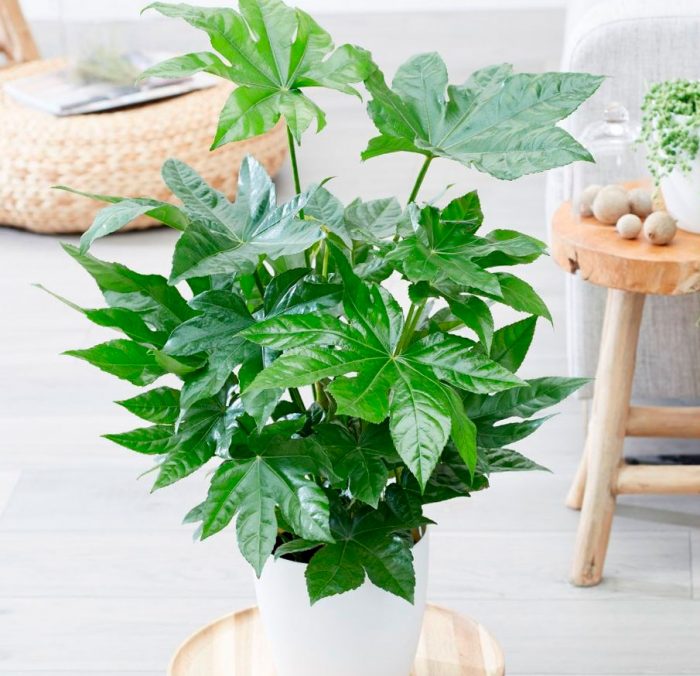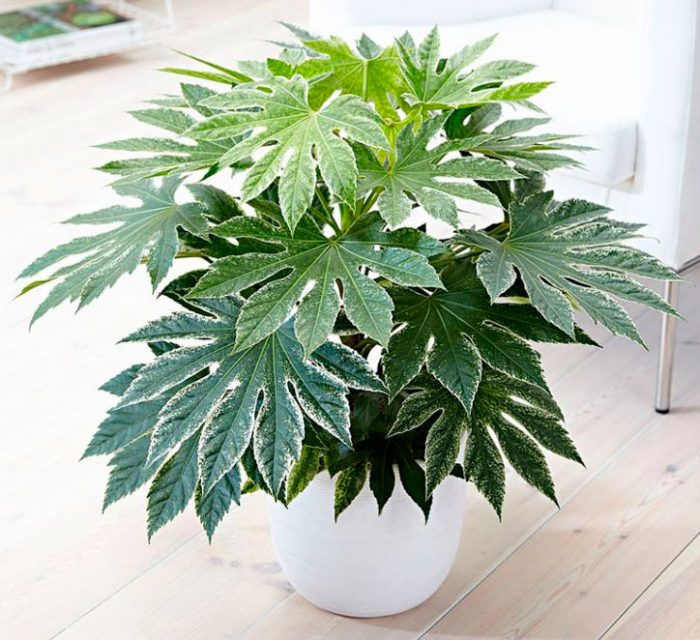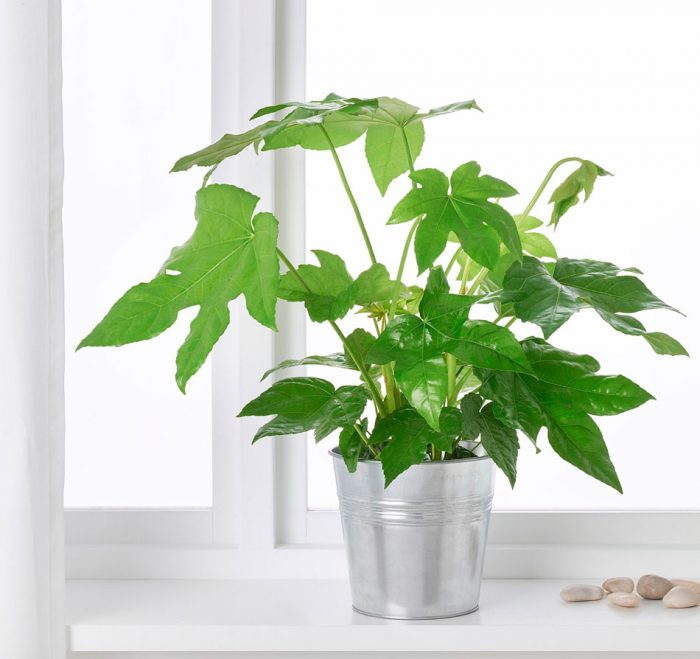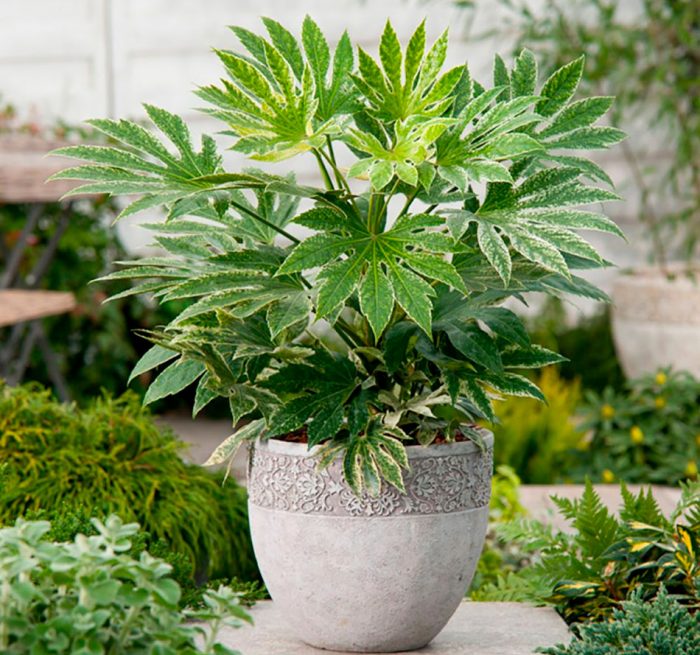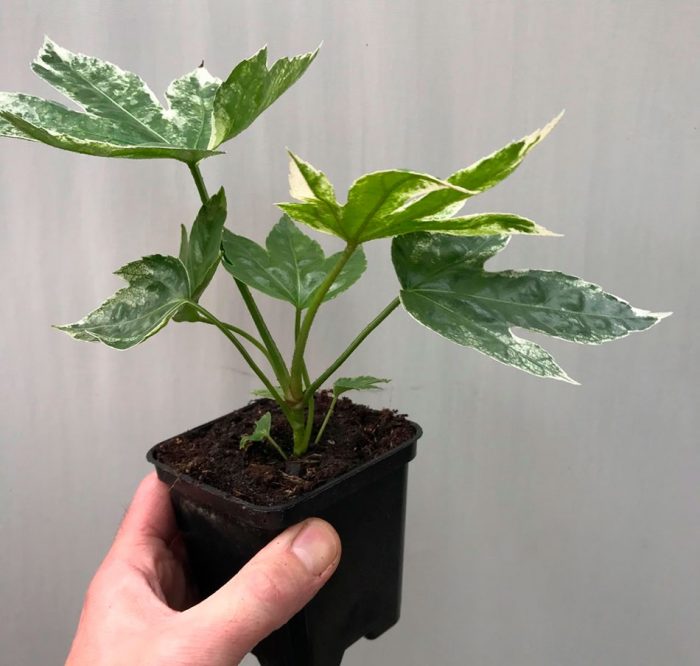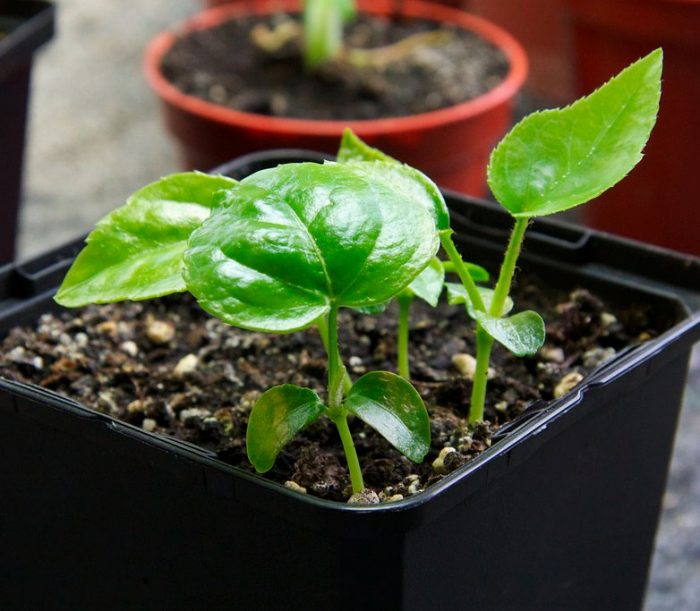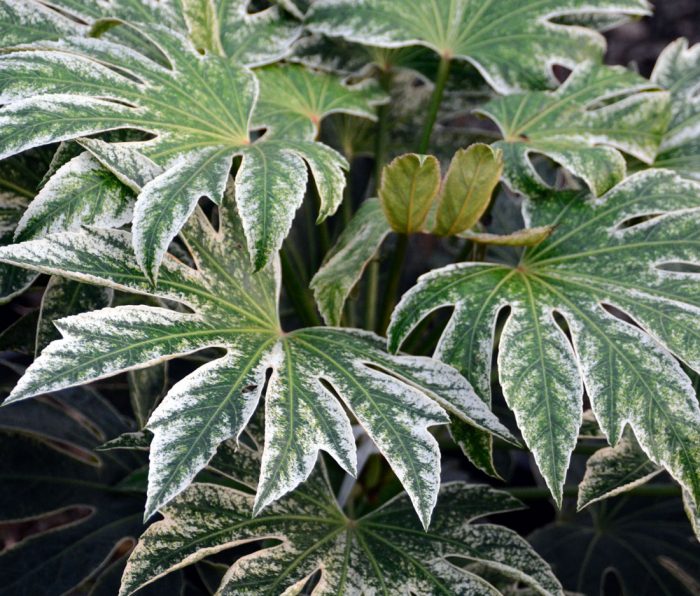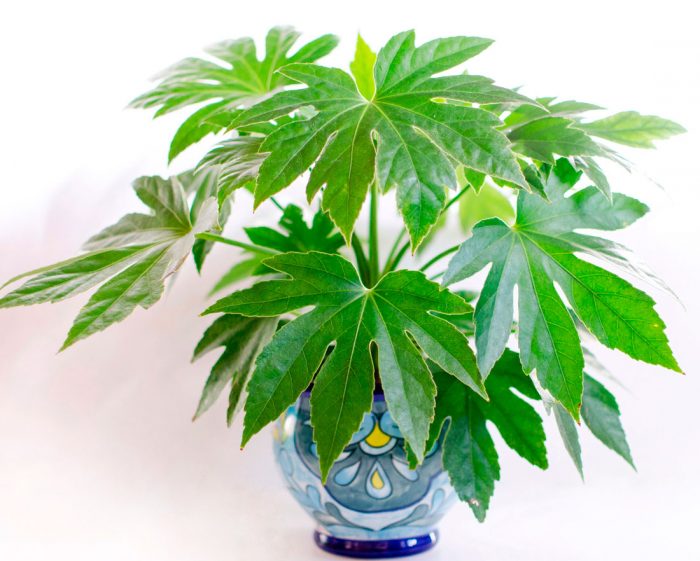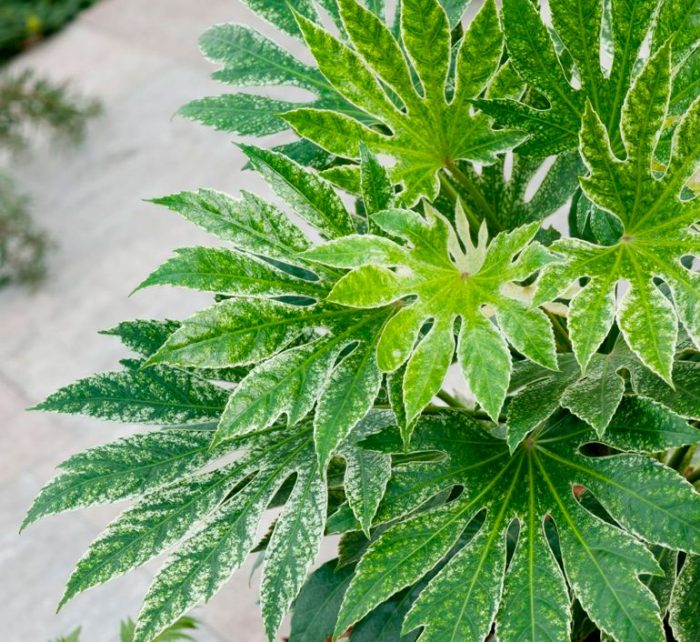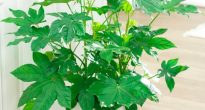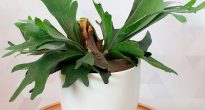The people of the Japanese Fatsia (Fatsia japonica) are also called "Japanese chestnut", or "home chestnut". This is due to the fact that the spectacular large leaf plates of fatsia are very similar in shape and texture to maple or chestnut. Such a plant is distinguished by its vitality and unpretentiousness, while it is especially popular with interior designers.
In order for such a flower to grow well and have a spectacular appearance, it is provided with proper care. It is also important not to forget about the growing conditions, which should be favorable for Japanese Fatsia.
This perennial is quite easy to grow. With optimal nutrition and a sufficient amount of light, the flower grows quite actively. Flowering begins in the last summer weeks. At this time, panicle inflorescences appear on the bushes, consisting of small white flowers.
Content
Brief description of cultivation
- Temperature... In the warm season, the plant feels best at a temperature of about 20 degrees. In winter, he has a dormant period, during which the air temperature should be about 17 degrees.
- Air humidity... Can grow normally at low levels of humidity. However, the plant responds positively to systematic spraying from a spray bottle.
- Illumination... It grows well in moderate diffused lighting, protection from direct sunlight is needed. Also, places in the shade and partial shade are suitable for this flower, it develops normally under artificial lighting.
- Watering... The substrate in the pot should be slightly damp at all times. In the summer, watering is carried out once every three days, and in the winter months - once every 7 days.
- Soil mixture... For planting fatsia, you can use a purchased ready-made soil mixture. In order to cook it yourself, combine the turf and garden soil, as well as sand and peat. Loosen the surface of the substrate regularly.
- Fertilizer... They are fed twice a month during active growth. Experts advise using for this alternately organic matter and a mineral complex in liquid form.
- Transfer... It is carried out if necessary, when the root system becomes cramped in the pot.
- Reproduction... Most often propagated by cuttings, while they should have buds.You can also grow fatsia from seeds.
- Care features... Remember that this is a moisture-loving and shade-tolerant plant. During the winter months, he has a dormant period. If the stems of the bush are very elongated, then they are pruned.
Caring for Japanese Fatsia at home
Bloom
Indoor Japanese fatsia is grown as an ornamental deciduous plant. Her flowers are very small and inconspicuous. During flowering, which is very rare at home, small inflorescences are formed, which in turn are collected in umbrellas. Despite the lack of a spectacular appearance, the flowers have a very pleasant subtle scent. Most growers cut the flower stalks immediately after they appear, without waiting for the flowers to open.
When flowering is over, small blue berries will form in place of the inflorescences. They contain poison, so you shouldn't eat them! The seeds in them do not have time to fully ripen. And even if this happens, they still quickly lose their germination.
Temperature regime
For normal growth and development of fatsia, an optimal air temperature is required, which differs depending on the season. The optimum air temperature in the spring-summer period is 18-25 degrees, and in the cold season - about 17 degrees.
This plant needs a constant supply of fresh air, while it is not harmed by frequent ventilation and even drafts.
Air humidity
The plant needs high humidity. Since the foliage constantly evaporates moisture, it is recommended to systematically moisten the bush from a spray bottle to replace it. To do this, use well-settled non-cold water.
On the hot summer days of Japanese Fatsia, you can sometimes arrange a warm shower. To do this, the bush is transferred to the bathroom and its foliage is washed with warm water, while the pressure should be low. In winter, when kept cool, it is not necessary to moisten the flower.
Illumination
Grows normally in both moderate light and shade. An east or west window sill is best suited for a flower. If desired, in the summertime, the fatsia can be transferred to the terrace or balcony, while choosing a place for it protected from direct sunlight.
If the sunlight is excessively bright, then burns may form on the foliage. Too little lighting can cause leaves to fall. Therefore, the northern windowsill is not suitable for fatsia. If the plant lacks natural light, then it is recommended to provide backlighting. For example, fluorescent lamps are suitable for this.
Watering
Particular attention should be paid to watering the fatsia. It should be systematic and moderate. The plant can suffer from both a lack of water and from its stagnation in the soil mixture. In the warm season, watering should be more frequent compared to the autumn-winter period.
The water is used soft and not cold. It must definitely settle for several days. Despite the fact that in winter the plant is watered sparsely, make sure that the earthen lump in the pot does not dry out completely.
Pot selection
When choosing a pot for Japanese fatsia, the first step is to pay attention to how many centimeters the root system reaches in diameter. In this case, the diameter of the container should be larger than this parameter by only a few centimeters.
If the container is too large, it can cause the liquid to stagnate in the substrate. Because of this, rot appears on the root system. In an extremely small capacity, the root system will soon become very crowded. Do not forget to make a drainage layer of expanded clay at the bottom of the pot during planting or transplanting.
Suitable soil mixture
Indoor fatsia is undemanding to the composition of the soil mixture. If desired, ready-made soil mixture can be purchased at a specialized store. It can also be prepared at home, for this simply combine turf, peat and sand.It is best to buy a ready-made soil mixture in transparent packaging, in this case you have the opportunity to see in advance the quality substrate or not.
Top dressing
This plant is fed only during the growing season, which lasts from March to November. 1 time in 15 days, complex mineral fertilizer and organic matter are alternately introduced into the soil mixture.
It is necessary to apply fertilizer to the substrate after watering. If it is added to a dry soil mixture, it can negatively affect the condition of the plant. Fatsia is not fed during the winter months.
Japanese fatsia transplant
The young bush is characterized by intensive growth and development. Therefore, for the first few years, it is transplanted annually, and spring is best suited for this. Remember to replace the pot with a larger one each time. An adult bush is transplanted less often, namely: 1 time in 2 or 3 years. As a rule, this is done only after the root system becomes very cramped in the container, and this can be understood by the roots peeping out of the drainage holes.
To begin with, a drainage layer of expanded clay should be made at the bottom of the container, which should have a thickness equal to 1/3 of the height of the pot. Sprinkle it on top with a layer of substrate. The bush is transplanted using the transshipment method. This procedure must be carried out very carefully so as not to destroy the earthen lump and not damage the root system. When the bush is placed in a new pot, all voids are covered with fresh earth mixture.


Watch this video on YouTube
Pruning
In order for the crown to be neat and effective, Japanese fatsia requires systematic pruning, which is carried out 1 time in 2 or 3 months. You will also need to pinch the upper leaf plates, thanks to this you can direct their growth in the direction you need.
Dormant period
In winter, the plant is dormant. At this time, he has a slowdown in growth, and at the same time, the bush should be provided with certain conditions: coolness, reduction in the frequency and abundance of watering. But do not forget to take care of the flower, otherwise it may die.
Is it possible to leave Fatsia without leaving for the duration of the vacation?
Japanese Fatsia is quite capable of living for several days without leaving, however, it should be prepared for this period. Moisten the soil mixture with plenty of water and cover its surface with wet expanded clay. Move the pot to the floor in a place where the sun's rays won't hit the plant. But remember that even in this case, the Fatsia cannot live long without your attention. Therefore, it is better to ask someone to come and water the flower.
Reproduction methods
Cuttings
As a rule, the harvesting of Japanese fatsia cuttings is carried out in the spring, after buds have formed and swell on the shoots. Best of all, the segments are rooted in a mixture of sand and peat, while the optimum air temperature is about 20 degrees. To create a greenhouse effect, cover the section on top with a glass jar or a transparent plastic bag.
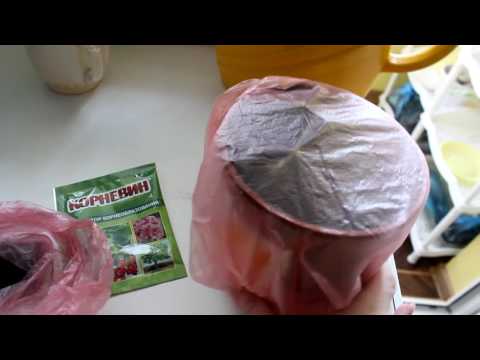

Watch this video on YouTube
Air layering
The bush is propagated by air layers also in the spring. Make several small cuts in the trunk at different locations. These places should be covered with plastic wrap. After a few days, roots should appear at the site of the incision. The finished cut is cut from the parent bush along with the roots and planted in a separate container. The remaining trunk needs to be watered regularly, after a while young shoots should appear.
Growing from seeds
Fill a bowl with a mixture of leaves, sand and soil. Dip the seeds into the substrate 10 mm, and cover the container on top with glass or foil. After the height of the seedlings that have appeared is 10 centimeters, they are seated in individual containers.
Possible problems
As a rule, problems with home fatsia arise only if the rules of care are regularly violated. For example:
- The foliage has lost its turgor and dries... The room is too hot or too little watering.
- The shoots are very elongated... If systematic pruning is neglected, it can lead to strong and rapid pulling of the stems.The lower leaf plates fly around, and the bush becomes more like a palm tree.
- Light spots on foliage... They appear due to too bright sunlight and are burns.
- Slowing down the growth of the bush... Excessively poor lighting.
- The foliage has turned brown... She feels an acute shortage of nitrogen.
- Young foliage at the top of the stem turned black... The plant was exposed to hypothermia.
- Pests... Aphids, mealybugs, ticks, whiteflies and thrips can settle on the bush. The flower can be treated with an appropriate insecticide, but this can harm it. Experts advise using mechanical pest control and resorting to chemicals only as a last resort.
Japanese Fatsia varieties
Fatsia Spider's Web
The foliage has an unusual shape and pointed tops. It is painted in a uniform color and has inclusions of a lighter shade.
Fatsia Variegata Variegata
The foliage is shaped like an open palm, with each tip like a finger. The leaf plate is colored dark green, with spots of various sizes of a lighter shade on it.
Fatsia Aureimarginatis
The foliage is similar in shape to the Fatsia Variegata variety. It is painted in a dark green shade, and decorated with a pale yellow border.
Fatsia Argenteimarginatis
Green foliage has an almost white edging. This makes it appear silvery.
Useful properties of Japanese fatsia
Japanese fatsia has medicinal properties. It is used in medicine to treat diseases of the joints and skin, and its analgesic and restorative properties are also appreciated. In alternative medicine, a decoction is prepared from the foliage of such a flower, which is used for colds, overwork and diabetes.
In order to quickly stop the blood flowing from a small wound, simply rinse the leaf of this plant in clean water and put it on it. However, there is another opinion that the foliage of this plant contains toxins that can cause irritation on the skin. That is why it is recommended to work with Fatsia with rubberized gloves.
Fatsia is also credited with mystical properties. Some growers believe that it helps to improve the mood of the owner, as well as strengthen his family happiness.


Watch this video on YouTube

